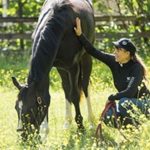Medicinal mushrooms are growing in popularity in both the human and pet wellness realms. They’re becoming a staple in many health regimens, whether for maintaining health, or for helping manage various health conditions.
But what about horses? Are medicinal mushrooms a yay or neigh (sorry, couldn’t help ourselves there) for our equine friends.
Today, we’re discussing the turkey tail for horses – a well researched mushroom with so many incredible benefits.
Is it something you should be adding to the rotation?
Turkey Tail Mushrooms
Turkey tail actually has two Latin names: Trametes versicolor and Coriolus versicolor. It is a polypore fungus that grows abundantly across the northern hemisphere on fallen logs and stumps, particularly dead alder and other deciduous trees. It is easy to spot, with its fan-shaped fruiting body and wide variety of rainbow-like rings of colour.
Nutritionally, turkey tail, grown in its native environment, provides a significant source of:
- Vitamin B Complex
- Vitamin D
- Calcium
- Potassium
- Magnesium
- Iron
- Zinc
- Manganese
- Copper
- Selenium
- Essential amino acids
- Polysaccharides (beta-glucans)
- Triterpenoids
- Vitamin B Complex
- Vitamin D
- Calcium
- Potassium
- Magnesium
- Iron
- Zinc
- Manganese
- Copper
- Selenium
- Essential amino acids
- Polysaccharides (beta-glucans)
- Triterpenoids
Turkey Tail Research
Traditionally and clinically, turkey tail is one of the most widely used and researched mushrooms on the planet. For centuries, it has been indicated for immune dysfunction and cancer. Chinese and indigenous human cultures have been using medicinal mushrooms including turkey tail for thousands of years. Science is now revealing some of its amazing healing properties.
The medicinal properties of turkey tail include its unique nutrient signature and two unique chemicals known as PSK (polysaccride-K) and PSP (polysaccharide peptide). In double extractions, you get the added benefit of mushroom triterpenes as well.
Multiple studies show that PSK may inhibit tumor growth of several forms of aggressive cancer in humans and animals (1) (2) (3) (4) (5) (6)
PSP has been shown to be equally beneficial, especially in the case of cancer, having the ability to modulate immune function and reduce aggressive tumor growth. (7) (8)
Triterpenes are yet another type of highly medicinal chemical in the chitin (armour) of the mushroom. They can only be obtained via alcohol extraction (see below for more information on the process).
[READ THIS NEXT] Leaky Gut in Horses: 10 Tips for Healthy Healing
Double/Triple Extracted Mushrooms Vs. Single Extraction
When it comes to mushrooms, we believe liquid extracts are much better than powder. This is because liquid extracts are able to hold and preserve the many bioactive compounds that come out during extraction. Liquid extractions are also easier to absorb than powder, as the body doesn’t need to digest anything, and therefore the body can absorb the medicinal properties of the mushroom.
Making double extracted herbs and mushrooms involve two major steps. First, the mushrooms are steeped in boiling water to extract the beta-glucans. Then, a second extraction is done by straining the remaining mushroom material off and steeping it in alcohol to extract the triterpenes found only in the chitin structure of the mushroom. With triple extraction, a third process is involved, using glycerin. Once the extraction process is complete, there is 0% alcohol left.
This dual/triple extraction gives a wider range of medicinal benefits and this is why liquid extracts may be more effective.
The Benefits of Turkey Tail for Horses
While there is little published research on the direct effects of turkey tail for horses, there are a number of companies that have incorporated medicinal mushrooms into their equine health products with the intention of improving immune function, gut health, and recovery time in performance horses. This includes the Canadian Olympic equestrian teams!
In humans and animals, science shows that turkey tail is can support the body in the following areas:
- oxidative stress/systemic inflammation
- the gut
- the immune system
- cancer
- the heart
- the lungs
- the liver
- improving athletic performance
- adaptogenic benefits such as blood sugar balance
Horses may also benefit in the same ways since initial independent research shows that it reduces recovery time in performance horses. It’s also a great way to diversify your horse’s diet with nutrients they may not get through hay or synthetic feeds.
When it comes to our horses’ health, there are many different things we can add to the list of health supporting supplements. Turkey tail for horses is definitely at the top of that list.
References
- Clinical & Experimental Metastasis: Protein-bound polysaccharide PSK inhibits tumor invasiveness by down-regulation of TGF-beta1 and MMPs, 2000
- Clinical Cancer Research: Polysaccharide Krestin is a novel TLR2 agonist that mediate inhibition of tumor growth via stimulation of CD8 T cells and NK cells, 2011
- Anitcancer Research: Effect of krestin (PSK) as adjuvant treatment of the prognosis after radical radiotherapy in patients with non-small cell lung cancer, 1993
- Oncogene: PSK-mediated NF-kB inhibition augments docetaxel-induces apoptosis in human pancreatic cancer cells NOR-P1, 2003
- International Journal of Oncology: PSK enhances the efficacy of docetaxel in human gastric cancer cells through inhibition of nuclear factor-xB activation and surviving expression, 2010
- Cancer Epidemiol Biomarkers & Prevention: Neonatal inoculation with the protein-bound polysaccharide PSK increases resistance of adult animals to challenge with syngeneic tumor cells and reduces azoxymethane-induced precancerous lesions in the colon, 2000
- BMC Complimentary Alternative Medicine: Induction of cell cycle changes and modulation of apoptogenic/anti-apoptotic and extracellular signalling regulatory protein expression by water extracts of I’m-Yunity (PSP), 2006
- Evidence Based Complimentary Alternative Medicine: Single Agent Polysaccharopeptide delays metastases and improves survival in naturally occurring hemangiosarcoma, 2012












